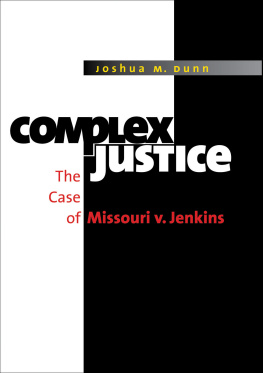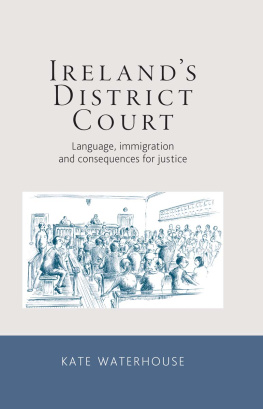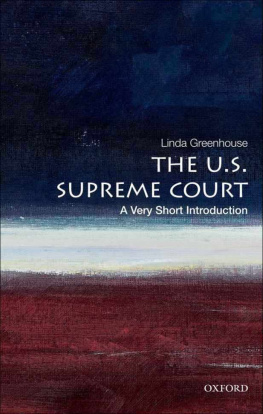COMPLEX JUSTICE
2008
The University of North Carolina Press
All rights reserved
Manufactured in the United States of America
Designed and typeset in Arnhem and The Sans by Eric M. Brooks
The paper in this book meets the guidelines for permanence and durability of the Committee on Production Guidelines for Book Longevity of the Council on Library Resources.
Library of Congress
Cataloging-in-Publication Data
Dunn, Joshua M.
Complex justice: the case of Missouri v. Jenkins / Joshua M. Dunn.
p. cm.
Includes bibliographical references and index.
ISBN 978-0-8078-3139-7 (cloth: alk. paper)
1. Segregation in educationLaw and legislationUnited States. 2. Segregation in educationLaw and legislationMissouriKansas City.
I. Title.
KF4155.D86 2008
344.730798dc22 2007039029
cloth 12 11 10 09 08 5 4 3 2 1
for Charles and Carol Dunn
Contents
From Segregation to Litigation
The Ambiguous Racial History of Missouri and Kansas City
Courthouse Magic
Educational Vice Becomes Legal Virtue
Waking Up
Implementing an Educational Disaster
Ambivalence and Anger
The Response of Kansas Citys African American Community
Illustrations and Tables
Illustrations
Proposed Kansas City, Missouri, superdistrict
KCMSD recruitment advertisement
Tables
1.1 Constraining Cases and Precedents on Desegregation and Education, 19541977
2.1 Level of Desegregation in KCMSD Schools, 19551957
2.2 Kansas Citys Black and White Populations, 19201990
3.1 Outcomes of KCMSD School Levy Elections, 19641983
3.2 KCMSD Student Racial Composition, 19741984
4.1 Parent Evaluation of Childs Education, 1986
5.1 KCMSD Student Racial Composition, 19841995
Acknowledgments
In setting out to write this book, it was my good fortune to have the advice and support of several remarkable individuals: Jim Ceaser, Martha Derthick, Sid Milkis, and Brian Balogh. I owe a special thanks to Martha Derthick and Jim Ceaser, who have supported this project in many ways from the very beginning. It was, in fact, Martha who initially suspected that Missouri v. Jenkins was hiding something interesting and suggested a closer look. As Ive found with everything else, she was correct.
Several other friends, colleagues, and institutions have helped me along the way. In 20002001, I was a Fellow in Public Affairs at the University of Virginias White Burkett Miller Center, which provided significant financial and intellectual support. This fellowship also supplied the pretext for asking Shep Melnicks advice on the project. He has been an invaluable mentor ever since. From 2002 to 2004 the Department of Government at the College of William & Mary was an exceptionally congenial and supportive environment for a visiting professor. In particular, John McGlennon and Ron Rapaport made Morton Hall a delightful place to work. Joel Schwarz and the Roy R. Charles Center provided research support at a critical time as well. Since coming to the University of ColoradoColorado Springs as an assistant professor, I have been blessed with the support of my department chair, Jim Null, and the Center for the Study of Government and the Individual. Dan Ponder and Paul Sondrol have provided guidance that only senior colleagues can. John Dinan read the entire manuscript and saved me from many errors. Bob Stacey, Rob Martin, Dan DiSalvo, Jim Colvin, and Octavius Pinkard endured my many musings on the case. I was fortunate that the University of North Carolina Press asked Jeremy Rabkin and David Levine to be external reviewers. Both provided exceptionally thorough and helpful comments, criticisms, and suggestions. I am also greatly indebted to Chuck Grench of UNC Press, who supported me at a very early stage and navigated me through the entire process. As well, Katy OBrien and Mary Caviness at the Press deserve my deepest gratitude for their significant efforts producing and editing this book.
Many individuals from Kansas City, including Arthur Benson, Clinton Adams, Edward Newsome, Mark Bredemeier, Jack Cashill, John Rios, and Eugene Eubanks helped me navigate the history of the case and Kansas Citys educational politics. In particular, Arthur Benson and Clinton Adams were extraordinarily generous with their time and answered many questions I know they must have tired of by the time I arrived. The staff at the Western Historical Manuscript Collection at the University of MissouriKansas City helped me navigate Arthur Bensons files from the case.
Finally, I owe the greatest debt to my family. Their support and encouragement has meant more than they know. My brother, Charlie, and sisters, Teresa and Maria, have expressed an interest in this project for its entirety, with Teresa providing a sharp editorial eye. My wife, Kelly, has read multiple drafts of this book and has shown me undeserved patience. Without her this book would not exist. My children, Joshua, Benjamin, and Elizabeth, give me more joy than I thought possible. My parents, Charles and Carol, to whom I dedicate this book, have provided lifelong love and support and shown me the educational value of a happy home.
COMPLEX JUSTICE
Introduction
On the corner of Indiana Avenue and Linwood Boulevard in a decaying neighborhood in Kansas City, Missouri, the unsuspecting driver will come across a surprising sight: Central High School, a building that Americas wealthiest school districts could only dream of. Walking insidepast armed guards and a bank of metal detectorsis to enter an unparalleled educational facility. A computer for every pupil, a six-lane indoor track, a natatorium with an underwater viewing room, and an Olympic-quality gymnastics center are just some of the amenities. The facilities are so extravagant that the building has been dubbed the Taj Mahal.
Just a few miles south of Central is another surprising sight: the Paseo Academy of Fine and Performing Arts, a school with every amenity a drama or music teacher could imagine. The surprises continue a few miles away at Southwest High School. There you will find a model United Nations with simultaneous translation capability. In fact, pick almost any public school in Kansas City, whether elementary, junior high, or high school, and you will find that it is housed in a state-of-the-art facility or in a completely renovated building with additions like climate-controlled art galleries, greenhouses, and petting zoos.
How does an urban school district afford such facilities? How does a school district, whose enrollment fell from 70,000 students in 1970 to less than 26,000 in 2006, justify them? The answer: Missouri v. Jenkins.
Missouri v. Jenkins, Browns Grandchild
In 1954, with its decision in Brown v. Board of Education, doctrine of separate but equal no longer applied to public schools. The decision would be the beginning of a long judicial effort to desegregate Americas schools. Even though the issue in Plessy was racial segregation in railroad cars, the Court referred to segregated school systems to buttress its claim that separate did not imply unequal: The most common instance of this [legal segregation] is connected with the establishment of separate schools for white and colored children, which has been held to be a valid exercise of the legislative power even by courts of States where the political rights of the colored race have been longest and most earnestly enforced. With







